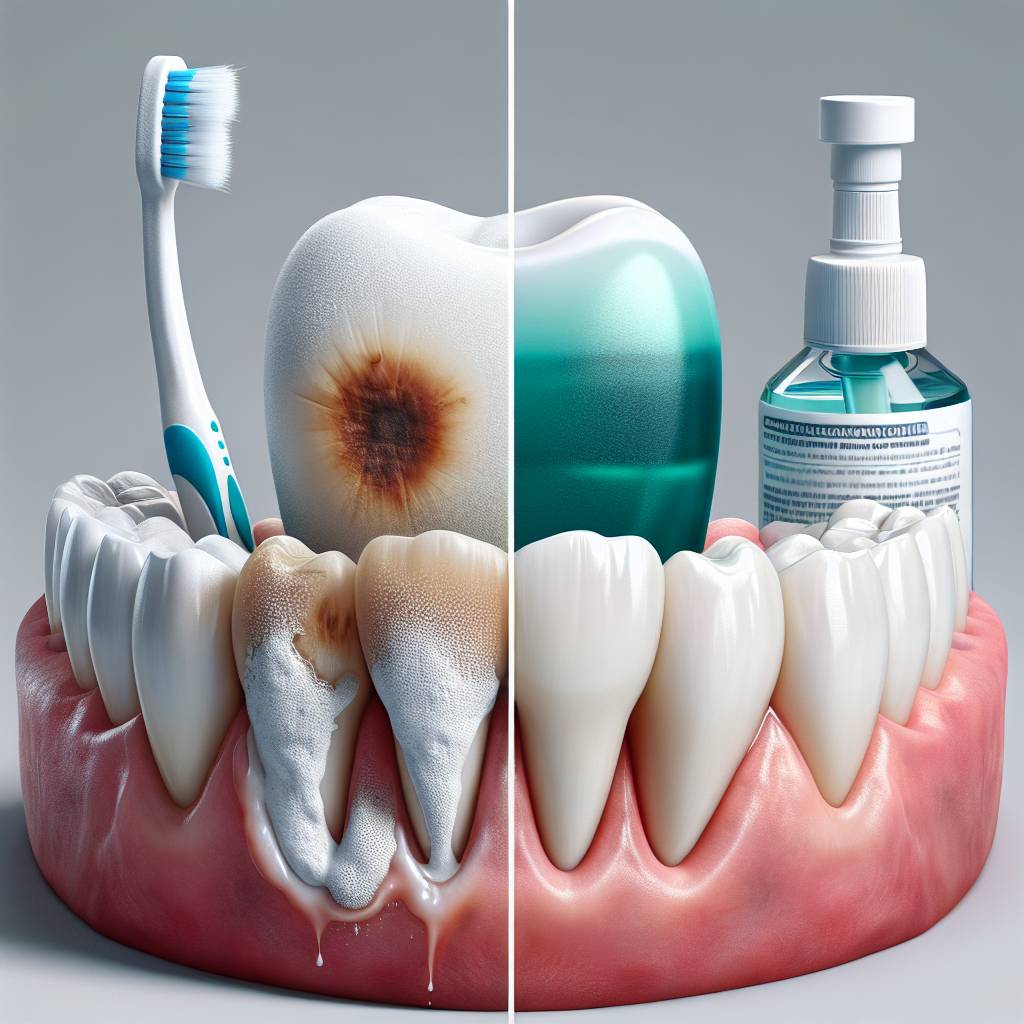Having stained teeth can be a source of embarrassment and self-consciousness. Fortunately, there are a variety of ways to get rid of stains on teeth. From using natural remedies to professional whitening treatments, you can find an option that suits your lifestyle and budget. This article will provide an overview of the different methods for getting rid of stains on teeth and offer advice on how to maintain your results.To get rid of stains on teeth, brushing twice a day with a whitening toothpaste can help remove surface stains. Flossing daily and using a mouthwash can help reduce the amount of bacteria that cause plaque, which leads to staining. Additionally, using a whitening rinse or tray-based system at least once per month can help remove deeper stains. Avoiding foods and drinks that stain teeth, such as coffee and red wine, can also help prevent new stains from forming.
Natural Ways to Remove Stains from Teeth
Having stained teeth can be quite embarrassing, but fear not! There are plenty of natural remedies that can help to remove those unsightly marks. Here are some easy and effective ways to get your teeth looking their best.
Brushing regularly with a natural whitening toothpaste is one of the most effective ways to keep stains at bay. It’s important to choose a brand that is free from harsh chemicals, as these can damage your tooth enamel over time. Additionally, you should also make sure you brush gently and for at least two minutes each time.
Another way to naturally remove stains is by using baking soda. Baking soda has natural whitening properties, so it’s great for removing tough stains on the teeth. To use it, simply mix some baking soda with water and use it as a paste on your teeth. Leave the paste on for about five minutes before rinsing off with water.
You can also use hydrogen peroxide as an effective stain remover. Hydrogen peroxide has bleaching properties that help to lighten the surface of your teeth, making them appear whiter and brighter. To use it, mix one part hydrogen peroxide with two parts water and swish around in your mouth for a minute or two before rinsing off with water.
Finally, another great way to naturally remove stains from your teeth is by eating crunchy fruits and vegetables like apples and celery. These foods act like “natural abrasives” which help to scrub away surface stains from the enamel of your teeth. Additionally, they also help to increase saliva production which helps keep bacteria levels low in the mouth and prevent new stains from forming.
The Benefits of Brushing and Flossing Regularly
Brushing and flossing your teeth on a regular basis is an important part of maintaining good oral health. Regular brushing and flossing helps to remove plaque, which can lead to cavities, gum disease, and other serious dental health problems. It also helps to reduce bad breath by removing food particles that can get stuck between teeth. In addition, brushing and flossing can help to keep your teeth looking white and healthy.
Brushing your teeth twice a day is recommended by most dentists. When you brush, use a soft-bristled toothbrush and fluoride toothpaste. Be sure to use circular motions when brushing and make sure to reach all areas of the mouth, including the back molars. Flossing once a day is also recommended, as it helps to remove food particles that are stuck between the teeth which cannot be removed by brushing alone. When flossing, be sure to use gentle motions so as not to damage the gums.
The benefits of regular brushing and flossing go beyond just preventing cavities and gum disease. It can also help improve overall health by reducing bacteria in the mouth that can enter the bloodstream through open sores or inflamed gums. This bacteria has been linked to inflammation throughout the body which can lead to conditions such as heart disease or stroke.
In conclusion, regular brushing and flossing is an important part of maintaining good oral health. Not only does it help prevent cavities, gum disease, and bad breath; it also helps improve overall health by reducing bacteria in the mouth that could lead to other serious medical conditions.

Best Foods for Healthy Teeth
Eating a balanced diet that includes certain foods can help keep your teeth healthy. Foods rich in calcium and phosphorus, as well as those that help stimulate saliva production, can help protect your teeth against decay. Additionally, some foods can also help clean your teeth while you eat them. Here are some of the best foods for healthy teeth:
Cheese, yogurt and other dairy products are great for your teeth. Dairy products are high in calcium and phosphorus, which strengthens tooth enamel and helps prevent cavities. They also contain casein, a protein that helps protect against tooth decay by providing a physical barrier on the surface of the teeth.
Leafy green vegetables like spinach and kale are high in calcium and vitamin A, both of which promote healthy teeth. Vitamin A helps keep gums healthy by reducing inflammation while calcium helps to strengthen tooth enamel.
Fruits such as apples, pears and oranges are rich in fiber and water. Eating them stimulates saliva production, which washes away bacteria and food particles that cause plaque buildup on teeth. Additionally, crunchy fruits can act like natural tooth brushes when eaten as they scrub away plaque from the surface of the teeth.
Nuts such as almonds, walnuts and peanuts contain vitamins E and B which help to maintain healthy gums. They also provide essential minerals such as phosphorus, zinc and magnesium which promote strong tooth enamel.
Seeds like sunflower seeds are high in vitamin D which helps our bodies absorb calcium to strengthen our teeth’s enamel defenses against decay-causing bacteria. Sunflower seeds also contain selenium which has been found to reduce inflammation of the gums.
Including these foods in your diet will help keep your teeth healthy and strong so you can enjoy all the benefits of having a great smile!
Foods and Drinks to Avoid for Whiter Teeth
It is important to maintain good oral hygiene in order to keep your teeth looking white and healthy. One of the best ways to do this is by avoiding certain foods and beverages that can stain or damage your teeth. Coffee, tea, red wine, and dark-colored sodas are all known culprits when it comes to discoloring your teeth. Additionally, acidic foods such as citrus fruits and tomatoes can also erode your enamel over time, making it easier for stains to set in.
Candy and sugary treats should also be kept to a minimum as the sugar can break down the enamel of your teeth. Sticky candy in particular can be difficult to remove from between your teeth and can lead to cavities if not brushed away properly. Hard candies such as lollipops should also be avoided as they can cause chips or cracks in the enamel of your teeth.
Sugary drinks such as soda are also a no-no when it comes to keeping your smile white. The acidity in these beverages along with the added sugar can wreak havoc on your enamel, leading to discoloration over time. If you must indulge in these types of drinks, try sipping them through a straw so that less of the liquid touches your teeth directly.
Overall, maintaining good oral hygiene and avoiding certain foods and drinks are key components of keeping your smile looking bright and healthy. By making smart dietary choices now you can ensure that you will have a stunningly white smile for years to come!
Pros and Cons of Charcoal Toothpaste for Stains
Charcoal toothpaste has become increasingly popular in recent years as a way to whiten and brighten teeth, and also to help remove tough stains. While this type of toothpaste may seem like an ideal solution for those looking to improve their smile, there are both pros and cons that should be considered before making the switch.
One of the major benefits of using charcoal toothpaste is its ability to absorb stains from teeth. Charcoal is highly absorbent, which makes it effective at removing harsh stains from foods and drinks such as coffee, tea, and red wine. It can also help to lighten discoloration caused by smoking or poor oral hygiene.
Another benefit of charcoal toothpaste is that it is composed of natural ingredients. Most charcoal toothpastes are made from activated charcoal, which is a form of carbon derived from natural sources such as coconut shells or bamboo. This makes them an ideal choice for those who are looking for a natural alternative to traditional whitening products.
The biggest downside to using charcoal toothpaste is that it can be abrasive on teeth and gums if used too often or with too much pressure. Overuse can lead to enamel erosion, which can make teeth look duller over time instead of brighter. Additionally, some people may find that their teeth are more sensitive after using charcoal toothpaste due to the abrasiveness of the ingredients.
Overall, charcoal toothpaste can be an effective way to remove tough stains from teeth and lighten discoloration caused by poor oral hygiene or smoking. However, it should only be used sparingly as it can be abrasive on teeth and gums if used too often or with too much pressure.

Conclusion
In conclusion, having stained teeth can be an embarrassing situation. Fortunately, there are a variety of ways to get rid of stains on teeth without spending too much money or time. Brushing and flossing regularly is the best way to prevent staining in the first place. But if you do need to remove existing stains, using whitening toothpastes, baking soda and hydrogen peroxide, or activated charcoal can all help you achieve a brighter smile. Professional dental whitening treatments are also an option if you want to get long-lasting results. With a little effort and some patience, you can get rid of those pesky stains on your teeth and show off your pearly whites with confidence.
Ultimately, maintaining good oral hygiene habits and visiting your dentist regularly is the best way to keep your teeth bright and healthy.

